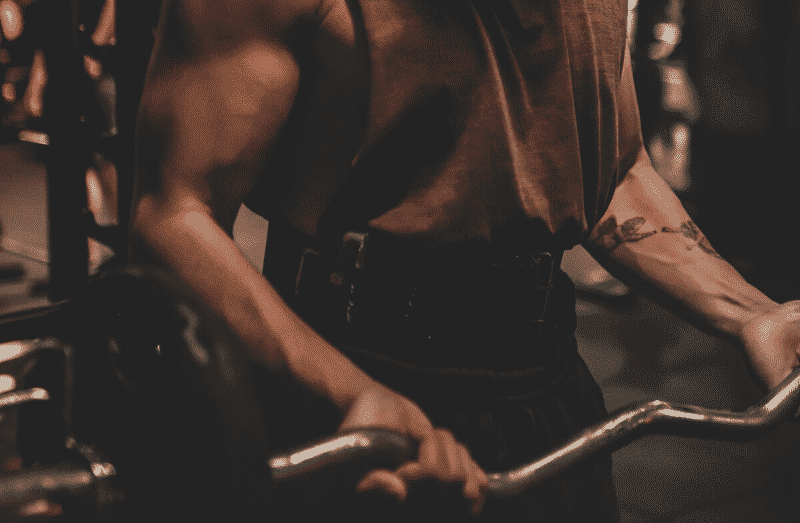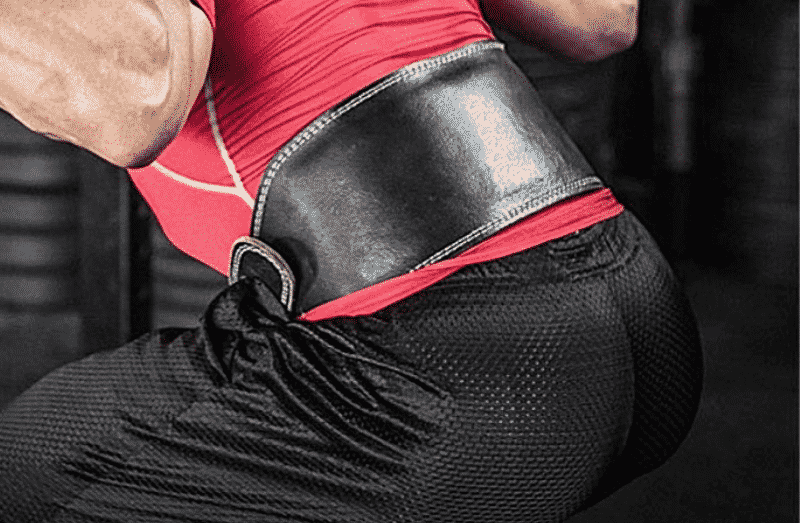We've all seen it before.
Somebody at the gym wearing a gym accessory incorrectly. We're left cringing at the fact that they may be doing more harm than good to their body.
Most gym accessories seem to be simple enough and yet there are people who always find a way to misuse them.
Weight lifting belts and powerlifting belts are not hard to wear. But they can be challenging to use properly. Using a lifting belt correctly all starts from how you put on the weight lifting belt.
Where on your torso should the lifting belt be? How far up? How far down? I even see some lifters wear their belt completely reversed.
If you’re not sure how to use this simple yet effective piece of equipment, you’ve come to the right place!
Let’s go over all the small details to look for when putting on a weight lifting belt.

Buckle’s Out
If you’re a football fan you will know the term ‘laces out’. It refers to the direction of the ball when a kicker gets ready to punt the ball.
The laces on the ball should always be in the opposite direction of where the kicker is. Why? Well if the laces were inwards and the kicker punts the ball it would have no direction. The ball would move erratically.
The same goes for a powerlifting belt or weight lifting belt. Keep the buckle pointing outwards. This is ALWAYS true for any type of lifting belt. Whether you have a prong, Velcro, or lever system, the buckle should face forwards.
Why? Well if the buckle’s final position is to be on your lower back, fastening would be quite difficult. You could always fasten it in the front and twist it. But, imagine trying to take the belt off? It would be quite a hassle to shift the belt forwards and rip it off after a heavy set.
Luckily, the position of the buckle isn’t only for convenience.
The True Purpose of The Buckle
Your torso is not a perfect cylinder. Most lifters have abdomens that protrude outwards. That is, a gut. Even the fittest athlete will have a small curve outward near their lower abs.
The buckle is tightest at the thickest part of your torso. This point is your abdomen. The lower back has a curve therefore will never be the thickest point.
Most people can relate to this with regular fashion belts. The buckle is the point where you feel it the most. Not your lower back.
Don’t mistake a lifting belt as a back support.
With the buckle at the front, your torso is snug with the belt. When you perform the Valsalva technique and brace, your abs need the most support. A tight lifting belt with the buckle at the front allows you to take full advantage of the belts’ benefits. Greatest bracing power is possible with this belt position.
Use Your Navel as a Compass
Now that we know how important the buckle is, we can move to the right way of putting on a weight lifting belt.
Your primary cue will be your navel. For most people the navel is 2-3 inches directly above their hip bones. I am using the hip as a reference here, not the waist line. Your waist is the circumference around your abdomen including the navel. Your hip bones are where your pants normally sit. Make sure you understand the importance of weight lifting belt sizing with our guide.
For most lifters, the lifting belt position right above their navel is perfect. I usually put on a weight lifting belt 1-2 inches above my navel.
Other lifters prefer their navel directly in the middle of the weight lifting belt. This position covers both the middle and lower abdomen but may be too low for some as we talk about in the next section.
Play with different positions of the lifting belt here. Always use your navel to understand where you feel the most comfortable. Ultimately, the position of your lifting belt boils down to two questions to ask yourself:
1. Does your lifting belt provide comfort with full range of motion?
2. Do your abs feel coverage from the lifting belt?
The first point is self-explanatory. But the second point is about maximizing the number of contact points for your lifting belt. Specifically, when you engage your core by bracing, you'll feel the belt push back.
This is why veteran lifters recommend using a lifting belt during core exercises. As a newbie, you will get a feel for how to engage your core and push against the lifting belt. If you feel pain while bending over your belt could be digging into your hip bone.

Your Hip is A Restriction
It's just as important to understand the wrong lifting belt position. Our readers come from different backgrounds and shapes. What fits one lifter may not fit another.
You need to understand when a lifting belt hurts you, it could be the belt and not your technique.
As I said earlier, feel free to move your lifting belt around to find what is comfortable for you. I highly recommend doing hip hinge movements with the belt on. You will feel if the lifting belt is too low when you bend at your hips.
“Ouch” is exactly what you’ll feel and want to yell.
What is happening here? The lower part of your weight lifting belt is digging into the hip bone. If you have one of those stiff leather powerlifting belts your belt will feel like it's stabbing you.
The pain will also be sharp for shorter lifters. A 3- or 4-inch belt may be too big to wear lower since it will cover more of your torso.
You can do one of two things here: break in your belt or move it above your navel. Check out our article on quick ways to break in your belt if you have a leather powerlifting variant.
Moving the lifting belt above your navel will prevent you from getting the stabbing pain. But also make sure you can brace properly. Check to see if you feel all your abs pushing against the belt. Remember it's all about more points of contact with the lifting belt.
You can angle your lifting belt to cover your abs and keep any padding on your lower back.
Check out our guide lifting belt tightness for more information about proper fitting.
Still feel stabbing hip pain while lifting even after breaking it in? I would suggest using a shorter belt or a non-leather lifting belt.
Final Thoughts
Putting on a weight lifting belt correctly is more challenging than it looks. To up your lifting game a belt will help. But only if you know what you’re doing.
The first step is positioning the belt to get the full support and stability of the belt. Your next step should be understanding how tight a weight lifting belt should be.
Unfortunately, not all pieces of gym equipment come with a user manual. But the community of lifters from Muscle Lead can be your guide!





